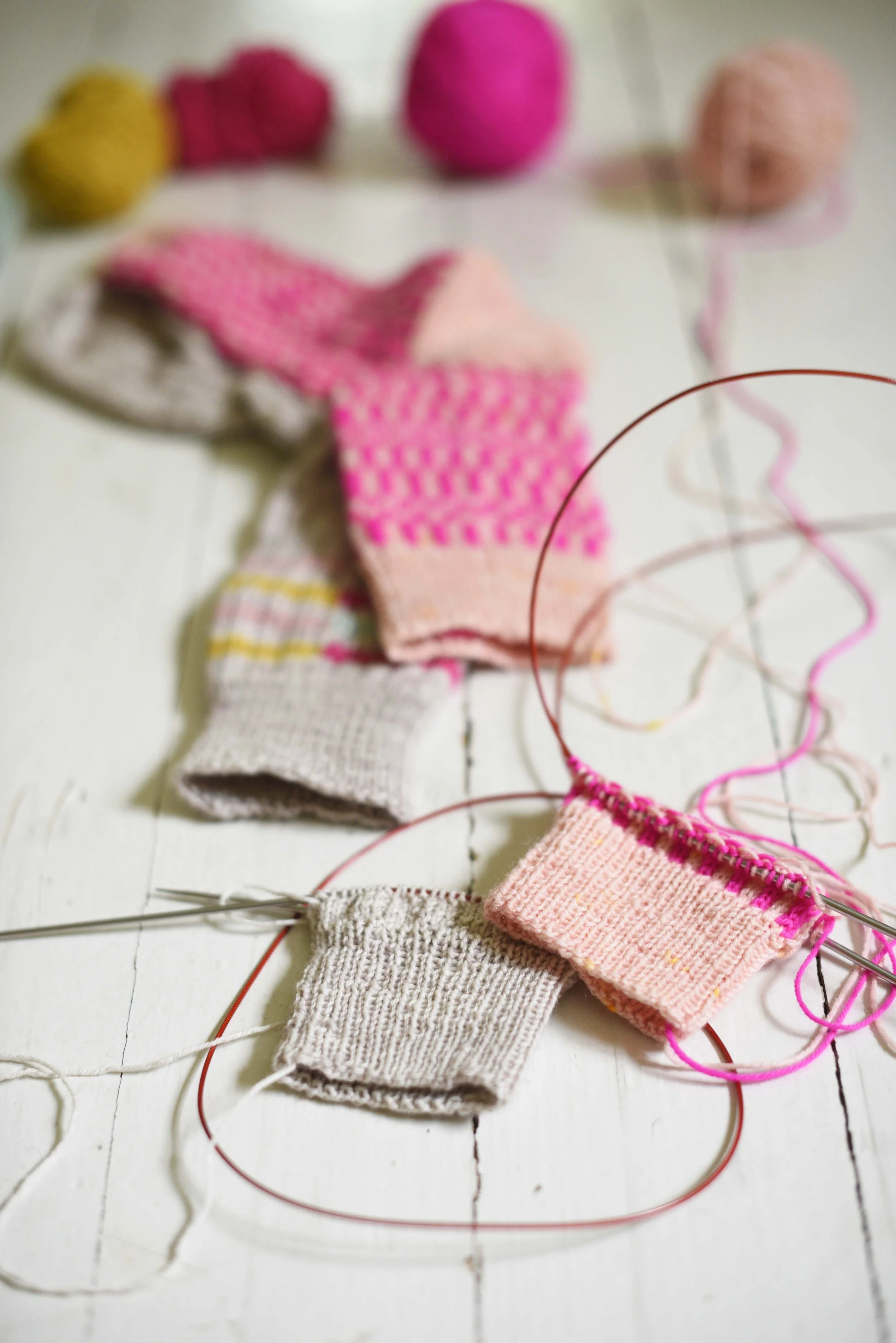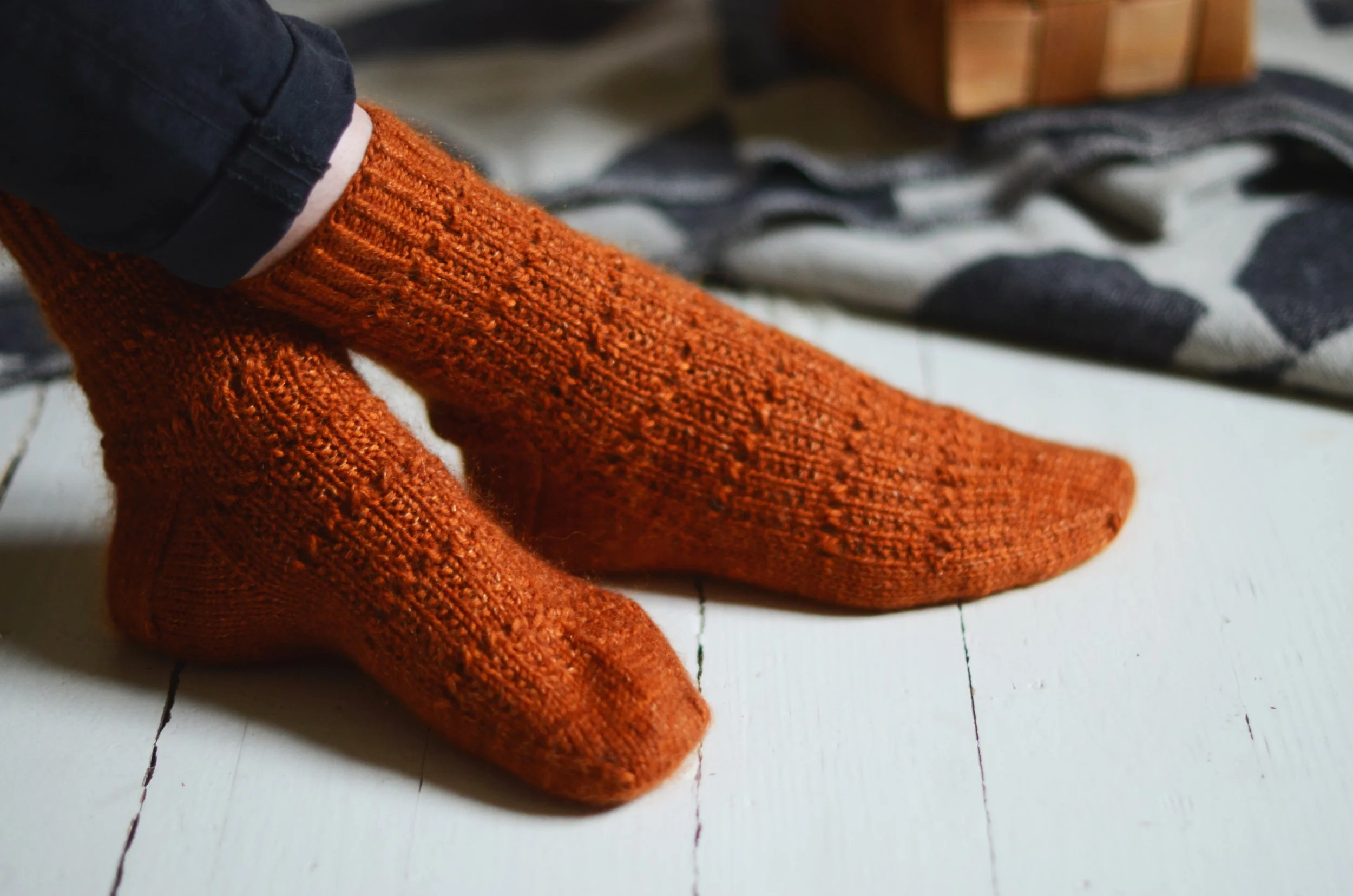Sock Knitting: Toe-Up or Cuff-Down?
Sock knitting posts continue! We have reached the midway point on our Spring Socks KAL and it’s the beginning of June already. Spring is changing into summer and I love it - and still love knitting my socks. So far I have finished 2 different socks and started each of their pairs. Here below you can take a look of these new designs - and see proof that I actually have started each second sock! No second sock syndrome my way, please and thank you!
Two new socks on the needles, as promised! Spring Sock KAL still going strong.
On today’s post I wanted to dive a little deeper in a big question in sock knitting. When you are knitting socks, first you need to choose direction. Toe-Up vs. Cuff-Down; which one is right for you?
Sock knitting is a delightful journey of small stitches, intricate patterns, and cozy creations. But when it comes to choosing your sock construction method, there’s one question that many knitters face: Should I knit toe-up or cuff-down? I seem to go from one to the other method based on my gut feel only, I just choose one that I feel like knitting. So in my designs you have plenty of examples of both! Maybe with the emphasis on cuff-down, because that’s what I (like so many other knitters) learned first.
Both methods offer unique advantages, and the best choice often depends on personal preference and the type of sock you want to make. Let's dive into the key differences between the two and help you decide which method is right for your next sock project!
Cuff-Down: The Classic Approach
The cuff-down method is the most traditional way to knit socks, starting with the cuff at the top of the sock and working your way down to the toe. It's the method that most knitters learn first, and it's popular for several reasons.
Advantages:
Better Fit for High Arches: One of the key benefits of cuff-down socks is that they allow for a better fit, especially for those with higher arches. The method allows you to customize the length of the leg, foot, and cuff, ensuring a snug fit in all the right places.
Easy to Try On: As you knit down from the cuff, you can easily try on the sock to check the fit. This is particularly helpful for adjusting the length of the leg, the cuff, or the foot.
Well-Known Construction: The cuff-down method uses familiar techniques, such as knitting the ribbing, working the heel flap, and closing the toe with a graft. If you’ve knit socks before, this method may feel like second nature.
Familiar Heel Options: From the classic heel flap and gusset to short-row heels, there are many different heel constructions you can explore with the cuff-down method. This makes it great for knitters who enjoy experimenting with various heel types.
Challenges:
Casting On Issues: When casting on for cuff-down socks, some knitters struggle with the cuff’s elasticity. A tight cast-on can result in a cuff that’s difficult to pull on, while a loose one can make the cuff too floppy. Finding a stretchy cast-on method, like the German twisted cast-on, is key to achieving a comfortable fit.
Yarn Management: If you’re using a single skein of yarn, you need to manage the remaining yarn as you work down the sock. You might run out of yarn before you finish the foot, leaving you scrambling for a solution.
Toe-Up: The Flexible Choice
Toe-up socks, as the name suggests, start at the toe and work upwards toward the cuff. This method offers a fresh perspective on sock construction, with its own set of advantages and challenges.
Advantages:
No Yarn Waste: One of the key benefits of toe-up socks is the ability to use every last inch of yarn. Since you start at the toe and knit towards the cuff, you can make your socks as long as you’d like without the worry of running out of yarn prematurely.
Perfect Fit: Because you knit toe-up, you can try the sock on as you go, adjusting the length of the foot, the leg, and the cuff to your ideal fit. This method also gives you the option to stop at any time if you run out of yarn.
Easy to Add Patterning: When you start at the toe, you can incorporate textured patterns or colorwork into the foot without worrying about them being upside-down. The whole design flows the way you intended it to.
Challenges:
Fewer Heel Options: The most common heel used in toe-up socks is the short-row heel, which some knitters may find trickier to execute, especially for beginners. While there are other heel options like the afterthought heel, these may require more advanced techniques.
Invisible Bind-Off: One of the trickiest parts of the toe-up method is the bind-off. A stretchy, invisible bind-off is crucial to avoid tightness at the cuff, but this can be challenging to master without practice.
Which Method Should You Choose?
At the end of the day, both the toe-up and cuff-down methods have their strengths, and the choice really comes down to your knitting preferences and the type of sock you want to create. Here's a quick guide to help you decide:
Choose Cuff-Down if:
You have a higher arch and need a more customizable fit.
You like trying on your socks as you knit.
You prefer to start with the cuff and work your way down.
You want to explore different heel constructions.
You’re looking for a tried-and-true method that’s familiar and comfortable.
Choose Toe-Up if:
You want to maximize your yarn usage.
You love the flexibility to adjust your sock size as you go.
You’re working with a specific amount of yarn and want to avoid running out.
You enjoy a challenge with short-row heels and advanced bind-offs.
Ultimately, both methods are wonderful ways to create beautiful socks. Whether you start at the toe or the cuff, your socks will be cozy and handmade with love. So, why not try both methods and see which one fits you best?


